A team of researchers at Freie Universität Berlin, Universität Hamburg, and Universidade Federaldo Ceará have developed a new material, demonstrating that they can mix matter with light.
The newly developed material shows the strongest coupling to light reported so far. The research team suggest that this material may be used in the future for computers that operate with light. The findings of the research team led by professor of physics Stephanie Reich at Freie Universität Berlin were published in the most recent issue of Nature.
“The material we synthesised consists of gold, but it appears pink and turquoise,” says physicist Dr. Niclas Müller, a researcher at Freie Universität Berlin. The synthetic crystals consist of tiny gold spheres, so-called nanoparticles, and they bind light.
“Inside the crystal, a beam of light becomes a mix of light and matter, in this case, excited gold electrons,” explains research group leader Professor Stephanie Reich. “To understand the colour and other properties of the nanoparticle crystals, we had to include light in our calculations.” Theoretical physicists have studied systems that extremely strongly couple with light for years but synthesising them proved difficult and expensive. “We designed a very simple system. The exotic conditions for light emerge naturally while the crystal forms,” says Reich.
Demonstrating the mixed light-matter state
For the publication, Reich and her group collaborated with the physical chemists Prof. Holger Lange and Dr. Florian Schulz at Universität Hamburg. Originally, the joint work aimed at novel materials for catalysis. Together with the theoretical physicists Prof. Eduardo Barros at the State University of Ceará in Brazil the groups realised that the real beauty of the crystals was their coupling with light. Before demonstrating the mixed light-matter state, the groups had to overcome multiple challenges. The researchers in Hamburg developed a method to grow high-quality artificial crystals of nanoparticles with 50 nanometres diameter – about the size of small viruses. The scientists in Berlin built special optical setups, and numerical simulations were run in Brazil.
“This particular crystal is our first step into this novel research field. We want to synthesise more materials by changing the microscopic crystal structure. In this way, we will fabricate materials with various properties from one building block,” says Stephanie Reich.









